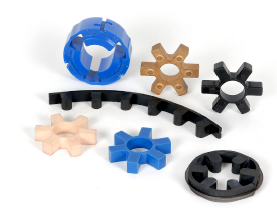Elastomers In Compression
We features four sorts of elastomer patterns to permit for more flexibility in addressing certain application needs. A single piece models are utilized in the “L” and “AL” models (known as spiders) and various component “load cushions” are utilized in the “C” and “H” model couplings. The load cushions are in sets of six to 14 pieces according to coupling size.
Solid Center Spider
The solid center design is generally made use of style and design when shafts of your driver and driven tools is often stored separate by a standard gap
Open  Center Spider
Center Spider
The open center design enables for the shafts on the driver and driven to get positioned inside of a brief distance
Open center spiders offer shaft positioning flexibility but possess a lower RPM capacity
Cushions
Employed solely for the C and H Kind couplings
Load cushions are held in place radially by a steel collar that’s attached to among the list of hubs
Snap Wrap Versatile Spider
Style will allow for simple elimination of the spider with no moving the hubs
Allows for close shaft separation all the way up to the hubs optimum bore
Greatest RPM is 1,750 RPM with all the retaining ring, but when utilised with all the LC Type (with collar) the typical RPM rating with the coupling applies
Design is obtainable in NBR and Urethane only, and in limited sizes
Spider Materials
SOX (NBR) Rubber
The common materials that’s remarkably versatile materials that is definitely oil resistant
Resembles organic rubber in resilience and elasticity, and operates properly in temperature ranges of -40° to 212° F (-40° to 100° C)
Urethane
Has one.5 occasions greater torque capacity than NBR
Great resistance to oil and chemical compounds
Material provides much less dampening impact and operates at a temperature array of -30° to 160° F
Hytrel
Flexible elastomer built for high torque and high temperature operations
Operates in temperatures of -60° to 250° F (-51° to 121° C)
Bronze
Rigid, porous, oil-impregnated metal insert solely for reduced pace (max 250 RPM) applications requiring substantial torque capabilities
Not affected by water, oil, filth, or severe temperatures – operates in temperatures of -40° to 450° F (-40° to 232° C)